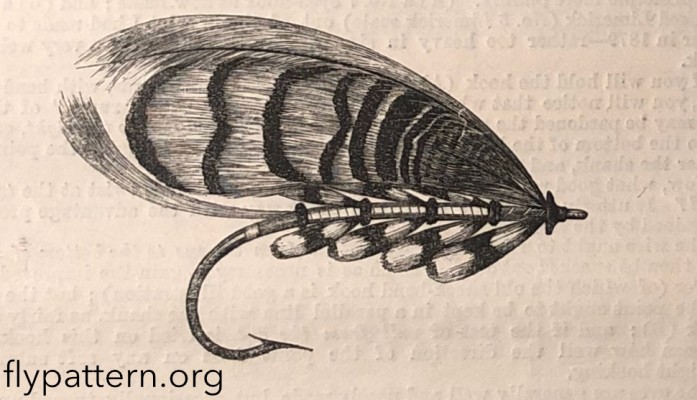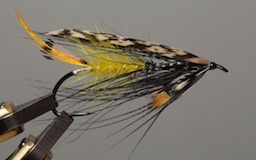| Author | Kelson, George M. |
| Book | The fishing gazette: On the description of salmon flies, Major Traherne's Patterns |
| Book Edition | N/A |
| From "The fishing gazette" - September 27th, 1884 WE have nearly done with the distinctive features in bodies, and without disturbing the dusty corners of one's recollection to brood over every-day particulars which the fly-dresser picks up in his infancy, there is little more to add. The ordinary chenilles behave uncommonly well in the water, but, as usual, the dyes are rather disappointing. I dip mine in a weak solution of tartaric acid to set the colours; some it suits, while others require a different mode of treatment. Another drawback is that they are rarely to be obtained sufficiently small for our work, the smalllest being quite large enough. Helbronner, in Oxford-street, supplies them, and his collection is an extensive one. If we include the tinselled sort, there is nothing to beat chenilles for grubs, and that kind could always be wrapped up in special paper sold with them, and kept as much as possible from the air and light. In tying in the ordinary, do not omit first to remove the flocculent finery by pinching it away with the finger-nails in diminutive quantities. When the ribs and hackle are companions down the body of any fly, the former is the first to wind and fasten off. The usual way of managing Peacock, Emu, and Ostrich herls is to tie in a couple and spin them on the thread. I can scarcely say a stronger, but a much more effective way is to use only one wound on its side in close coils, after the fashion of butts; it follows that the appearance in water is more life-like. I wish to say a few words by request on stripping hackles, my attention being called to an excellent work on angling, which in reference to this says, "Take care you strip off the right side." Coming from one considered a high authority, it is just possible "the right side" means the correct side, because it is unquestionably the left which we always take away. Another construction could be put upon it, as these feathers are on their backs, so to speak, when we double them, so the under part of them faces us during the operation, and therefore the sides then are reversed. However, it is not the first time I have known this subject under discussion, for I have been called over the coals myself. But in future let it be understood, as far as I am concerned, that the right and left sides are known by laying the feather with its point from and quill towards us,having the best side of it uppermost. I am indebted also to an old fly-dresser for pointing out a printer's error in another article of mine, July 26. It seems that I consider the hackle should be placed on the head side of the tinsel. Not at all; I am convinced that would be incorrect. The paragraph runs to this effect: The hackle follows alongside the tinsel on the head end; but that line is preceded by "He (the student) should endeavour to arrange his work (the work on the body) for the tinsel to guard the feather" (meaning the hackle), so that could not possibly hold good unless the hackle were located on the tag side. There were other reasons given August 23rd why it would be wrong the other way. However, if I were making a "show fly" I should certainly prefer the head side, because it looks so much better there. Beauty, at any rate, does not always guarantee security. I admit she is an ever-enticing lovely decoy-duck, but still a, "latent lurking cheat," having no power of endurance, and although she has her day she is utterly unreliable - she contaminates us, and then dims the mirror of our most ardent expectations. In all cases, from the beginning to the end of the work, the tying silk can be kept tight best by holding it between the third and little finger. All the materials that we require should be selected and in readiness, but if both hands be wanted and the fly laid down the silk should be wound three or four times spirally up to the head and squeezed in between the gut loop and shank of the hook, and for so doing sufficient room is always left there. Now we come to throats, where it has often been said that no salmon fly is perfect without a few blue fibres. Jay is a great favourite, and the professionals use feathers from both wings, but those having the colour on the left of the shaft they wind the reverse way. We work the right easier, they are not more expensive, and amateurs always prefer them. The older the bird the better for many reasons. I intended to give an illustration for stripping these feathers, as they have the reputation of being very troublesome. This I hope to do later on, with descriptive particulars. The Vulturine guinea fowl is a good natural blue, and much longer in fibre. Unfortunately, it has no speckle; but for very large flies there is nothing so good, in my opinion, as our Gallina. It is true we have to come down to dye, but the double-speckled feather takes the stain very readily in any shade; the white spots, or rather speckles, are so white and otherwise suited that the brightest blue can be obtained, and depended upon perhaps for a longer time than with anything else. We cannot do better than make a note of this now that the season for collecting them is rapidly approaching. It is scarcely necessary to enumerate the other natural blues, as they are so well known. However, it is well to bear in mind that when any of the large feathers are intended for hackling, they should previously be well soaked in water. The tippet from the Amherst pheasant furnishes this part of the fly very prettilyy, and can be turned to good account here in different lengthed strands which can be dyed any color; it is not a good feather to roll on, be it remembered. When any kind of fibres are put in at the throat, you can get them to point properly by winding the tying silk far enough, but not too far, against the butt of the former hackle; without a little attention to this they would rest too flat, and if overdone, too perpendicular. Talking of pheasants, I am glad to have an opportunity of calling attention to an advertisement in another column from Hereford. All amateurs are well aware of the diffuculty of procuring good feathers of this description. I have had a specimen of the Amherst's sent on, and the fibres - perfect in "bend" and condition - measure no less sthen 3 3/4in. The rump feathers, too, would be invaluable in any river; and as to the toppings, they are far superior and similar in colour to those on the throat of the East Indian Argus. ( For the sake of recording an extraordinary bird, I may here mention that the other day I saw a leading tail feather 4 1/4in. in fibre, and although a cross between a Golden and an Amherst pheasant, this bird singularly enough retained the original marking of the former. It is not for sale.) The Elliots' are superb and very useful, and, I believe, the only specimens in this country. Reeves' is another excellent variety, producing many taking feathers; and the decided rifle green stripes in the Versicolors afford one other grand change for small flies. What could be a more interesting undertaking for any angler than to imitate this example of crossing suitable birds, and keeping his friends constantly supplied with all sorts of fresh material which he would assuredly have at his disposal? The tippets of the Amhers, white, not golden, show to great advantage in the wing of the "Evening Star." This is a new pattern to me, but fishermen can generally tell where and when to use them; the name is suggestive as well as the extreme contrast. Still, such a complete change to the ordinary and old-fashioned stock would be worth trying at any time of the day; indeed, in some rivers black and white command the most attention. It requires a good deal of patience to set the Jungle Cock legs. They ought to cloes, as we know these feaethers are not so very flexible, and they would probably skirt the water, unless the strean was rapid, if allowed to sprout from the body in a variety of shapes. The student will just as easily manage Jungle as any other feather after a little practice. "As easily?" Well, scarcely so. Still, we cannot except to progress or benefit much without some effort. This "Star" can be described: Tag: Silver twist and tippet-coloured silk (tippet written thus always refers to the golden pheasant). Tail: Topping. Butt: Black herl. Body: In four equal sections of silver tinsel, the first three having two jungle above and below, as illustrated, and butted; the last of Blue Rock-coloured silk, and the only one ribbed with silver tinsel. Throat: Two jungle as before (these feathers slightly increase in length from the opposite end of the body). Wings: Four Amherst pheasant tippets, back to back, as shown. Cheeks: Summer duck and two red crow, the former in advance; topping over. Horns: Red macaw. Head: Black herl. |
|
| Tags | traherne, kelson, fishinggazette, |
Material
- Tag: Silver twist and tippet-coloured silk (tippet written thus always refers to the golden pheasant)
- Tail: Topping
- Butt: Black herl
- Body: In four equal sections of silver tinsel, the first three having two jungle above and below, as illustrated, and butted; the last of Blue Rock-coloured silk, and the only one ribbed with silver tinsel
- Throat: Two jungle as before (these feathers slightly increase in length from the opposite end of the body)
- Wings: Four Amherst pheasant tippets, back to back, as shown
- Cheeks: Summer duck and two red crow, the former in advance; topping over
- Horns: Red macaw
- Head: Black herl

